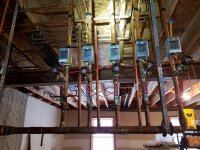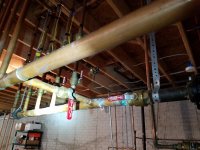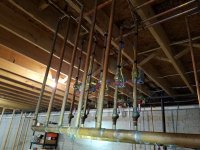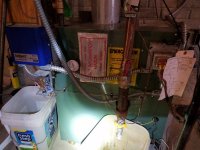Hey everybody I've got another question for the amazing people on this forum that will hopefully be easy for one of you experts to answer as it will hopefully be just an informational adventure for me. I've recently replaced the temperature pressure relief valve, expansion tank, and auto air vent for my boiler system to solve my over pressure and leak situation I had this winter which has since solved the problems. During the repair however I introduced some air into my system and it has started to create some noises. Through research I found out how to bleed the air out of a boiler system but what I currently have doesn't match those systems. Looking over what I have also raised some other questions on the purpose of various components that you fine people might be able to help me recognize and learn their function. I've attached a few pictures and questions below if anyone thinks they could help. Thank as always!
1. In picture 1 this is a picture of my zone valves that come from the output of my boiler after expansion tank and circulation pump. What is the purpose of the gate valves in this picture before the zone valves? I can't use these to bleed the system correct since they are on the output of boiler before the zones with trapped air? Are they just used to drain the individual zones for repairs?
2. In picture 2 there is a branch that connects the output side of the boiler to the input with a ball valve that is always in the closed position. On the output side it is located before the zone valves but after expansion and circulating pump. What is the purpose of this branch and valve? When would I ever want to turn it to the on position? Is it used to eliminate air if I shut off the valve going into the boiler? Confused....
3. In pictures 3 and 4 I'm showing the return side of the system into the input side of the boiler. Shouldn't there be a gate valve on this side to bleed air after forcing water to circulate the system? It seems to be missing as the only one is seen in picture 4 which heads into the boiler. Except when this is turned it drains the boiler without eliminating air. Would I need to add a gate valve to the left of the branch in pic 3 to bleed air if I shut off the ball valve to the input side of the boiler?
4. My last question is about the thermostats that are attached to the system. I have one attached to the output side of the boiler and one attached to the input side of the boiler pipe. I assume these are to prevent flue gas condensation with the return water being too cold. Is this correct? Is there a sweet spot that these should be turned to for a 1 story with basement ranch style house that is 2200 sq ft? Output is set to 200 degrees F and the input is 180 degrees F. What does the return thermostat do if it senses the water coming back is colder than the set point does it increase the speed of the circulating pump?
Holy block of text. Thank you so much for anyone that has read this far and can help!


1. In picture 1 this is a picture of my zone valves that come from the output of my boiler after expansion tank and circulation pump. What is the purpose of the gate valves in this picture before the zone valves? I can't use these to bleed the system correct since they are on the output of boiler before the zones with trapped air? Are they just used to drain the individual zones for repairs?
2. In picture 2 there is a branch that connects the output side of the boiler to the input with a ball valve that is always in the closed position. On the output side it is located before the zone valves but after expansion and circulating pump. What is the purpose of this branch and valve? When would I ever want to turn it to the on position? Is it used to eliminate air if I shut off the valve going into the boiler? Confused....
3. In pictures 3 and 4 I'm showing the return side of the system into the input side of the boiler. Shouldn't there be a gate valve on this side to bleed air after forcing water to circulate the system? It seems to be missing as the only one is seen in picture 4 which heads into the boiler. Except when this is turned it drains the boiler without eliminating air. Would I need to add a gate valve to the left of the branch in pic 3 to bleed air if I shut off the ball valve to the input side of the boiler?
4. My last question is about the thermostats that are attached to the system. I have one attached to the output side of the boiler and one attached to the input side of the boiler pipe. I assume these are to prevent flue gas condensation with the return water being too cold. Is this correct? Is there a sweet spot that these should be turned to for a 1 story with basement ranch style house that is 2200 sq ft? Output is set to 200 degrees F and the input is 180 degrees F. What does the return thermostat do if it senses the water coming back is colder than the set point does it increase the speed of the circulating pump?
Holy block of text. Thank you so much for anyone that has read this far and can help!




